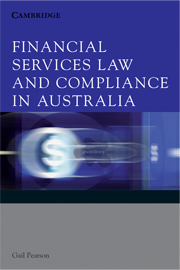Book contents
- Frontmatter
- Contents
- Preface
- List of Abbreviations
- Table of Statutes
- Table of Cases
- 1 The financial citizen and the market
- 2 The regulatory structure
- 3 An overview of financial services reform
- 4 Licensing financial services providers
- 5 The role of disclosure in the distribution of financial products
- 6 Selling financial products and other conduct
- 7 Deposit-taking and payments
- 8 Investment
- 9 Insurance
- 10 Consumer credit
- 11 Superannuation
- 12 Compliance, enforcement and remedies
- Index
- References
3 - An overview of financial services reform
Published online by Cambridge University Press: 05 June 2012
- Frontmatter
- Contents
- Preface
- List of Abbreviations
- Table of Statutes
- Table of Cases
- 1 The financial citizen and the market
- 2 The regulatory structure
- 3 An overview of financial services reform
- 4 Licensing financial services providers
- 5 The role of disclosure in the distribution of financial products
- 6 Selling financial products and other conduct
- 7 Deposit-taking and payments
- 8 Investment
- 9 Insurance
- 10 Consumer credit
- 11 Superannuation
- 12 Compliance, enforcement and remedies
- Index
- References
Summary
On ‘reducing costs’ and finding ‘regulatory burdens’.
New concepts for regulatory neutrality
This is a building blocks chapter, which analyses key FSR legal concepts that form the bedrock of regulatory neutrality and the gateway to licensing, disclosure and conduct obligations. These include ‘financial product’, ‘financial service’, ‘retail client’ and ‘wholesale client’. The chapter also comments on those matters which have been left out of the FSR framework, such as credit.
Financial products and services are regulated at a generic level through the Corporations Act 2001 (Cth) (Corporations Act) Part 7 Financial Services and Markets, and in the case of some products through industry-specific legislation. A new regime for financial services was constructed from 1998 to 2001. The reform process was driven by the Wallis Report into the effects of deregulation of the banking system and other changes to the financial system since the Australian dollar floated in 1983; and by the Corporate Law Economic Reform Program (CLERP). The Wallis Report's philosophy of regulation was that ‘free and competitive markets can produce an efficient allocation of resources and provide a strong foundation for economic growth and development’. In response to the Wallis Report, the then Treasurer articulated the goals of reform as creating a world-class regulatory structure for the development and growth of the whole Australian economy. The Wallis Report recommendations were the foundation of the government's Corporate Law Economic Reform Program (CLERP), which to date has issued nine papers, resulting in extensive legislative change.
- Type
- Chapter
- Information
- Financial Services Law and Compliance in Australia , pp. 69 - 103Publisher: Cambridge University PressPrint publication year: 2009



